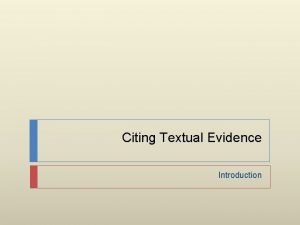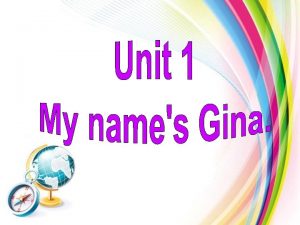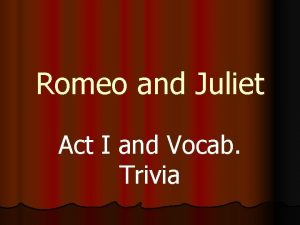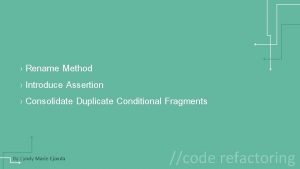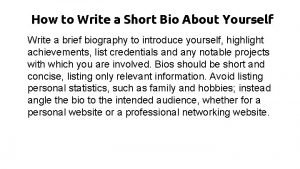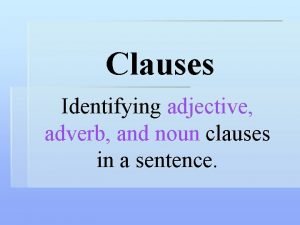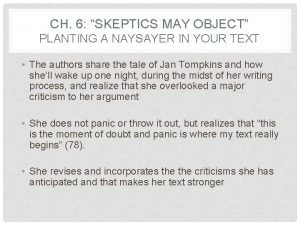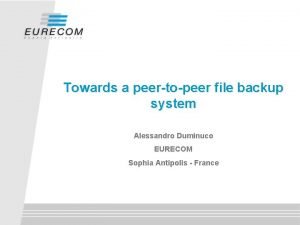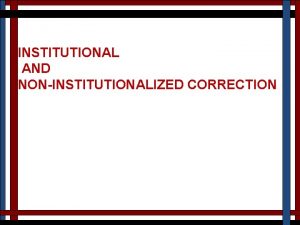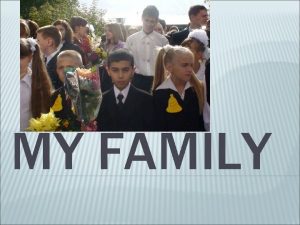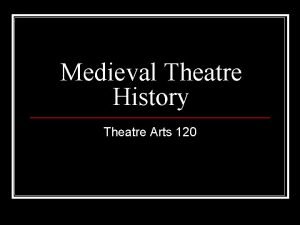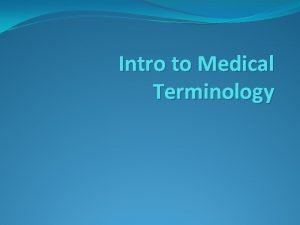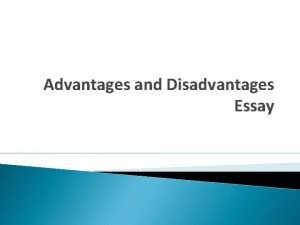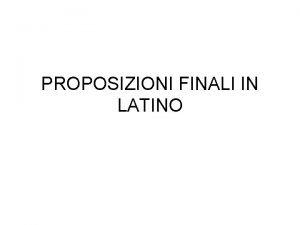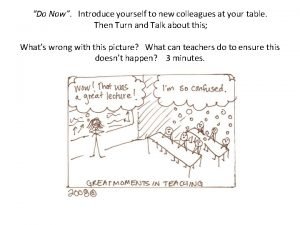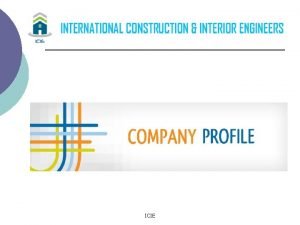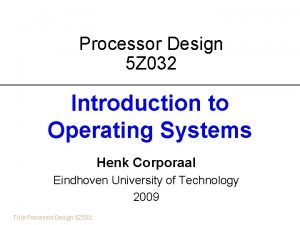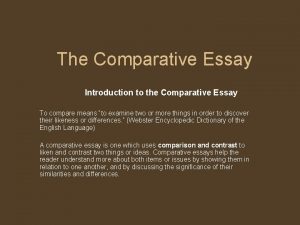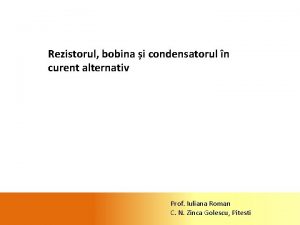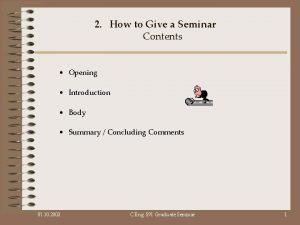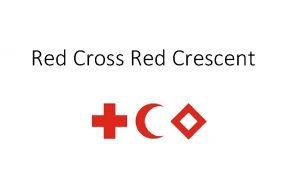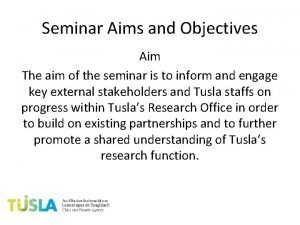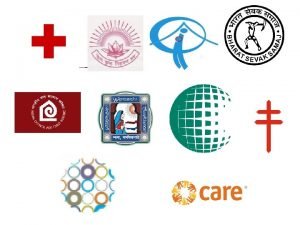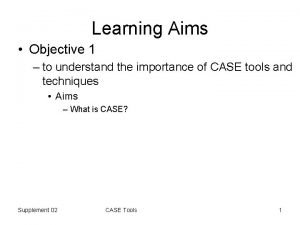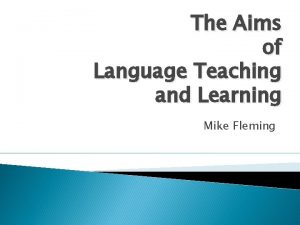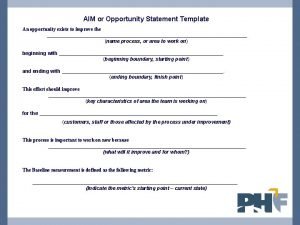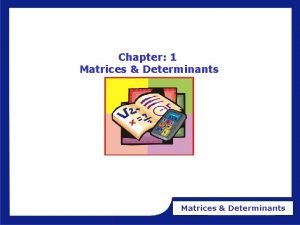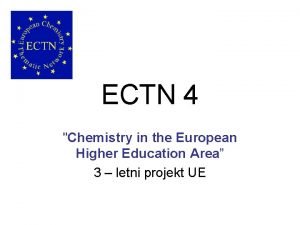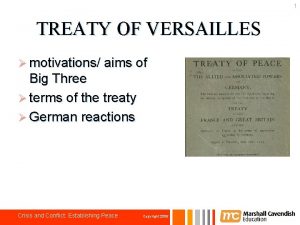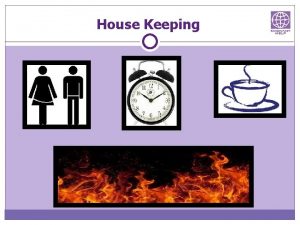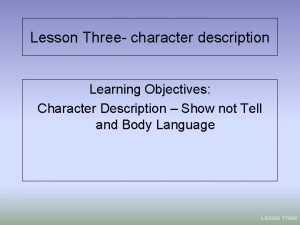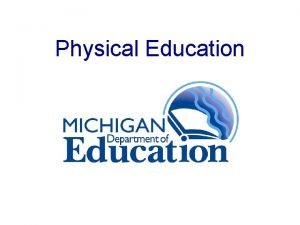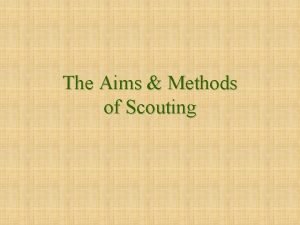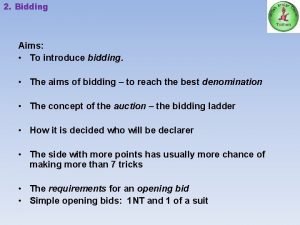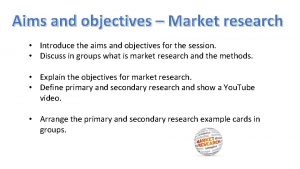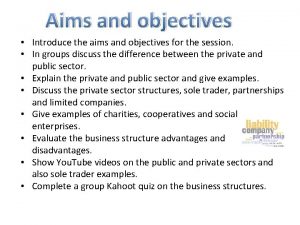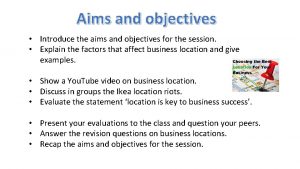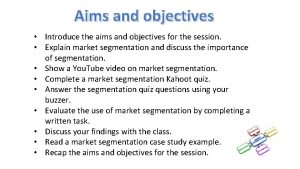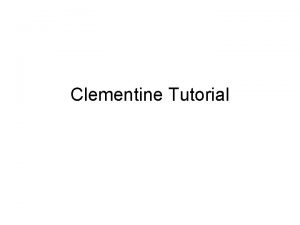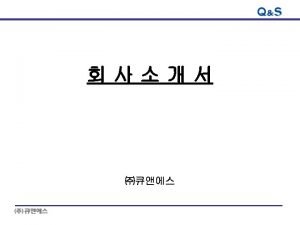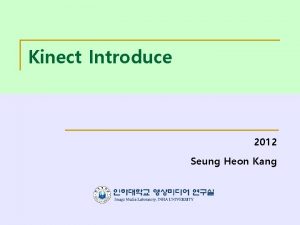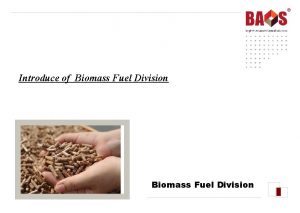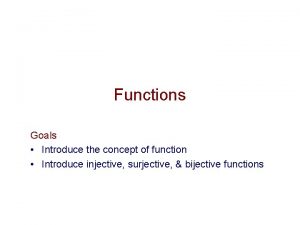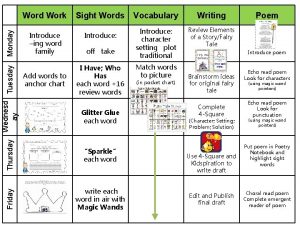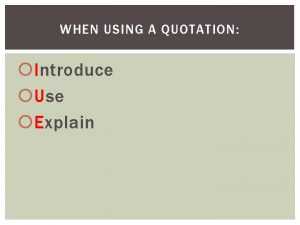The aims of this tutorial Introduce the aims












![Web Services: [Stencil Group] • loosely coupled, reusable components • encapsulate discrete functionality • Web Services: [Stencil Group] • loosely coupled, reusable components • encapsulate discrete functionality •](https://slidetodoc.com/presentation_image_h2/2be8c7d2c744e8f5c4070991708724db/image-13.jpg)




















































































































![References WSMO • [WSMO Specification]: Roman, D. ; Lausen, H. ; Keller, U. (eds. References WSMO • [WSMO Specification]: Roman, D. ; Lausen, H. ; Keller, U. (eds.](https://slidetodoc.com/presentation_image_h2/2be8c7d2c744e8f5c4070991708724db/image-130.jpg)
![References WSMO • • • [Arroyo et al. 2004] Arroyo, S. , Lara, R. References WSMO • • • [Arroyo et al. 2004] Arroyo, S. , Lara, R.](https://slidetodoc.com/presentation_image_h2/2be8c7d2c744e8f5c4070991708724db/image-131.jpg)


- Slides: 133


The aims of this tutorial • Introduce the aims & challenges of Semantic Web Services (SWS) to the Autonomic Computing community • Present a general overview of a fully fledged framework for SWS: a conceptual model, a language, and an execution environment • Investigate and discuss possible collaborations between SWS and Autonomic Computing communities

Agenda 8: 00 – 8: 30 – 9: 40 – 9: 55 – 10: 10 Part I: Introduction to Semantic Web Services Part II: Web Service Modeling Ontology (WSMO) - conceptual model Michal Zaremba Dumitru Roman Coffee Break Part II (cont’): Web Services Modelling Language (WSML) Part II (cont’): WSMO Discovery Dumitru Roman 10: 10 – 10: 50 Part III: Web Service Modeling Execution Environment (WSMX) Michal Zaremba 10: 50 – 11: 00 Summary, Conclusions, Future Work, Questions & Answers Dumitru Roman Michal Zaremba

PART I - overview • Introduction to Semantic Web • Introduction to Web services Þ Semantic Web Services

Semantic Web -The Vision – 500 million users – more than 3 billion pages Dynamic Static WWW URI, HTML, HTTP Syntax Semantics

Semantic Web -The Vision Serious Problems in Dynamic Static • • • information finding, information extracting, information representing, information interpreting and information maintaining. WWW Semantic Web URI, HTML, HTTP RDF, RDF(S), OWL Syntax Semantics

Semantic Web -The Vision Dynamic Web Services UDDI, WSDL, SOAP Bringing the computer back as a device for computation Static WWW Semantic Web URI, HTML, HTTP RDF, RDF(S), OWL Syntax Semantics

Semantic Web -The Vision Bringing the web to its full potential Dynamic Static UDDI, WSDL, SOAP Intelligent Web Services WWW Semantic Web URI, HTML, HTTP RDF, RDF(S), OWL Web Services Syntax Semantics

Ontology Definition unambiguous definition of all concepts, attributes and relationships conceptual model of a domain (ontological theory) formal, explicit specification of a shared conceptualization machine-readability commonly accepted understanding

Ontology Example name Concept conceptual entity of the domain attribute describing a concept Relation relationship between concepts or properties Axiom coherent description between Concepts / Properties / Relations via logical expressions Person matr. -nr. Property email research field is. A – hierarchy (taxonomy) Student Professor attends holds Lecture lecture nr. topic holds(Professor, Lecture) : Lecture. topic € Professor. research. Field

Ontology Languages • Requirements: – ”expressivity“ • knowledge representation • ontology theory support – ”reasoning support“ • sound (unambiguous, decidable) • support reasoners / inference engines • Semantic Web languages: – web compatibility – Existing W 3 C Recommendations: • XML, RDF, OWL

“Semantic Web Language Layer Cake”
![Web Services Stencil Group loosely coupled reusable components encapsulate discrete functionality Web Services: [Stencil Group] • loosely coupled, reusable components • encapsulate discrete functionality •](https://slidetodoc.com/presentation_image_h2/2be8c7d2c744e8f5c4070991708724db/image-13.jpg)
Web Services: [Stencil Group] • loosely coupled, reusable components • encapsulate discrete functionality • distributed • programmatically accessible over standard internet protocols • add new level of functionality on top of the current web

Web Services Problems

Web Services Problems

Lack of SWS standards Current technology does not allow realization of any of the parts of the Web Services’ usage process: • • • Only syntactical standards available Lack of fully developed markup languages Lack of marked up content and services Lack of semantically enhanced repositories Lack of frameworks that facilitate discovery, composition and execution • Lack of tools and platforms that allow to semantically enrich current Web content

Semantic Web Services • Define exhaustive description frameworks for describing Web Services and related aspects (Web Service Description Ontologies) • Support ontologies as underlying data model to allow machine supported data interpretation (Semantic Web aspect) • Define semantically driven technologies for automation of the Web Service usage process (Web Service aspect)

Semantic Web Services (2) Usage Process: • Publication: Make available the description of the capability of a service • Discovery: Locate different services suitable for a given task • Selection: Choose the most appropriate services among the available ones • Composition: Combine services to achieve a goal • Mediation: Solve mismatches (data, process) among the combined • Execution: Invoke services following programmatic conventions

Semantic Web Services (3) Usage Process – execution support • Monitoring: Control the execution process • Compensation: Provide transactional support and undo or mitigate unwanted effects • Replacement: Facilitate the substitution of services by equivalent ones • Auditing: Verify that service execution occurred in the expected way

Conclusion Semantic Web Services = Semantic Web Technology + Web Service Technology

PART II - overview • Overview of WSMO: mission and working groups • WSMO building blocks: Ontologies, Web services, Goals, and Mediators • Specific aspects: – Web Service Modeling Language WSML – WSMO Discovery

WSMO is… • a conceptual model for Semantic Web Services : – Ontology of core elements for Semantic Web Services – a formal description language (WSML) – execution environment (WSMX) • … derived from and based on the Web Service Modeling Framework WSMF • a SDK-Cluster Working Group (joint European research and development initiative)

WSMO Working Groups A Conceptual Model for SWS A Formal Language for WSMO A Rule-based Language for SWS Execution Environment for WSMO

WSMO Design Principles Web Compliance Strict Decoupling Centrality of Mediation Ontology-Based WSMO Ontological Role Separation Execution Semantics Description versus Implementation

WSMO Top Level Notions Objectives that a client wants to achieve by using Web Services Provide the formally specified terminology of the information used by all other components Semantic description of Web Services: - Capability (functional) - Interfaces (usage) Connectors between components with mediation facilities for handling heterogeneities WSMO D 2, version 1. 2, 13 April 2005 (W 3 C submission)

Non-Functional Properties every WSMO elements is described by properties that contain relevant, non-functional aspects • Dublin Core Metadata Set: – complete item description – used for resource management • Versioning Information – evolution support • Quality of Service Information – availability, stability • Other – Owner, financial

Non-Functional Properties List Dublin Core Metadata Contributor Coverage Creator Description Format Identifier Language Publisher Relation Rights Source Subject Title Type Quality of Service Accuracy Network. Related. Qo. S Performance Reliability Robustness Scalability Security Transactional Trust Other Financial Owner Type. Of. Match Version

WSMO Ontologies Objectives that a client wants to achieve by using Web Services Provide the formally specified terminology of the information used by all other components Semantic description of Web Services: - Capability (functional) - Interfaces (usage) Connectors between components with mediation facilities for handling heterogeneities

Ontology Usage & Principles • Ontologies are used as the ‘data model’ throughout WSMO – all WSMO element descriptions rely on ontologies – all data interchanged in Web Service usage are ontologies – Semantic information processing & ontology reasoning • WSMO Ontology Language WSML – conceptual syntax for describing WSMO elements – logical language for axiomatic expressions (WSML Layering) • WSMO Ontology Design – Modularization: import / re-using ontologies, modular approach for ontology design – De-Coupling: heterogeneity handled by OO Mediators

Ontology Specification • Non functional properties (see before) • Imported Ontologies importing existing ontologies where no heterogeneities arise • Used mediators OO Mediators (ontology import with terminology mismatch handling) Ontology Elements: Concepts Attributes Relations Functions Instances set of concepts that belong to the ontology, incl. set of attributes that belong to a concept define interrelations between several concepts special type of relation (unary range = return value) set of instances that belong to the represented ontology Axioms axiomatic expressions in ontology (logical statement)

WSMO Web services Objectives that a client wants to achieve by using Web Services Provide the formally specified terminology of the information used by all other components Semantic description of Web Services: - Capability (functional) - Interfaces (usage) Connectors between components with mediation facilities for handling heterogeneities

WSMO Web service description - complete item description - quality aspects - Web Service Management - Advertising of Web Service - Support for WS Discovery Non-functional Properties Capability DC + Qo. S + Version + financial functional description client-service interaction interface for consuming WS - External Visible Behavior - Communication Structure - ‘Grounding’ Web service Implementation (not of interest in Web Service Description) WS WS WS realization of functionality by aggregating other Web Services - functional decomposition - WS composition Choreography --- Service Interfaces --- Orchestration

Capability Specification • • • Non functional properties Imported Ontologies Used mediators – OO Mediator: importing ontologies with mismatch resolution – WG Mediator: link to a Goal wherefore service is not usable a priori • • Pre-conditions What a web service expects in order to be able to provide its service. They define conditions over the input. Assumptions Conditions on the state of the world that has to hold before the Web Service can be executed Post-conditions describes the result of the Web Service in relation to the input, and conditions on it Effects Conditions on the state of the world that hold after execution of the Web Service (i. e. changes in the state of the world)

Choreography & Orchestration • VTA example: When the service is requested When the service requests Date, Time Date Hotel Service Time Error Flight, Hotel Error Confirmation VTA Service Date, Time Flight Service Error • • Choreography = how to interact with the service to consume its functionality Orchestration = how service functionality is achieved by aggregating other Web services

Choreography Aspects Interface for consuming Web Service • • External Visible Behavior – those aspects of the workflow of a Web Service where Interaction is required – described by workflow constructs: sequence, split, loop, parallel Communication Structure – messages sent and received – their order (communicative behavior for service consumption) Grounding – concrete communication technology for interaction – choreography related errors (e. g. input wrong, message timeout, etc. ) Formal Model – reasoning on Web Service interfaces (service interoperability) – allow mediation support on Web Service interfaces

Orchestration Aspects Control Structure for aggregation of other Web Services Web Service Business Logic State in Orchestration Control Flow 1 WS Data Flow Service Interaction 3 2 4 WS - decomposition of service functionality - all service interaction via choreographies

Orchestration Aspects • service interfaces are concerned with service consumption and interaction • Choreography and Orchestration as sub-concepts of Service Interface • common requirements for service interface description: 1. represent the dynamics of information interchange during service consumption and interaction 2. support ontologies as the underlying data model 3. appropriate communication technology for information interchange 4. sound formal model / semantics of service interface specifications in order to allow operations on them.

Service Interface Description • Ontologies as data model: – all data elements interchanged are ontology instances – service interface = evolving ontology • Abstract State Machines (ASM) as formal framework: – dynamics representation: high expressiveness & low ontological commitment – core principles: state-based, state definition by formal algebra, guarded transitions for state changes – overcome the “Frame Problem” • further characteristics: – not restricted to any specific communication technology – ontology reasoning for service interoperability determination – basis for declarative mediation techniques on service interfaces

Service Interface Description Model • Vocabulary Ω: – ontology schema(s) used in service interface description – usage for information interchange: in, out, shared, controlled • States ω(Ω): – a stable status in the information space – defined by attribute values of ontology instances • Guarded Transition GT(ω): – state transition – general structure: if (condition) then (action) – different for Choreography and Orchestration

Service Interface Example Communication Behavior of a Web Service Ωin has. Values { concept A [ att 1 of. Type X att 2 of. Type Y] …} State ω1 a member. Of A [ att 1 has. Value x att 2 has. Value y] received ontology instance a Ωout has. Values { concept B [ att 1 of. Type W att 2 of. Type Z] …} Vocabulary: - Concept A in Ωin - Concept B in Ωout Guarded Transition GT(ω1) IF (a member. Of A [ att 1 has. Value x ]) THEN (b member. Of B [ att 2 has. Value m ]) State ω2 a member. Of A [ att 1 has. Value x, att 2 has. Value m] b member. Of B [ att 2 has. Value m] sent ontology instance b

Future Directions Choreography: - interaction of services / service and client - a „choreography interface“ describes the behavior of a Web Service for client-service interaction for consuming the service Orchestration: - how the functionality of a Web Service is achieved by aggregating other Web Services - extends Choreography descriptions by control & data flow constructs between orchestrating WS and orchestrated WSs. Conceptual models User language - based on UML 2 activity diagrams - graphical Tool for Editing & Browsing Service Interface Description workflow constructs as basis for describing service interfaces: - workflow based process models for describing behavior - on basis of generic workflow constructs (e. g. van der Aalst) Formal description of service interfaces: - ASM-based approach - allows reasoning & mediation Ontologies as data model: - every resource description based on ontologies - every data element interchanged is ontology instance Grounding: - making service interfaces executable - currently grounding to WSDL

WSMO Goals Objectives that a client wants to achieve by using Web Services Provide the formally specified terminology of the information used by all other components Semantic description of Web Services: - Capability (functional) - Interfaces (usage) Connectors between components with mediation facilities for handling heterogeneities

Goals • Ontological De-coupling of Requester and Provider • Goal-driven Approach, derived from AI rational agent approach - Requester formulates objective independently - ‘Intelligent’ mechanisms detect suitable services for solving the Goal - allows re-use of Services for different purposes • Usage of Goals within Semantic Web Services – A Requester, that is an agent (human or machine), defines a Goal to be resolved – Web Service Discovery detects suitable Web Services for solving the Goal automatically – Goal Resolution Management is realized in implementations

Goal Specification • • • Non functional properties Imported Ontologies Used mediators – OO Mediators: importing ontologies with heterogeneity resolution – GG Mediator: • Goal definition by reusing an already existing goal • allows definition of Goal Ontologies • Requested Capability – describes service functionality expected to resolve the objective – defined as capability description from the requester perspective • Requested Interface – describes communication behaviour supported by the requester for consuming a Web Service (Choreography) – Restrictions / preferences on orchestrations of acceptable Web Services

WSMO Mediators Objectives that a client wants to achieve by using Web Services Provide the formally specified terminology of the information used by all other components Semantic description of Web Services: - Capability (functional) - Interfaces (usage) Connectors between components with mediation facilities for handling heterogeneities

Mediation • Heterogeneity … – Mismatches on structural / semantic / conceptual / level – Occur between different components that shall interoperate – Especially in distributed & open environments like the Internet • Concept of Mediation (Wiederhold, 94): – Mediators as components that resolve mismatches – Declarative Approach: • Semantic description of resources • ‘Intelligent’ mechanisms that resolve mismatches independent of content – Mediation cannot be fully automated (integration decision) • Levels of Mediation within Semantic Web Services (WSMF): (1) Data Level: (2) Protocol Level: (3) Process Level: mediate heterogeneous Data Sources mediate heterogeneous Communication Patterns mediate heterogeneous Business Processes

WSMO Mediators Overview

Mediator Structure Source Component WSMO Mediator 1. . n Source Component uses a Mediation Service via 1 Target Component - as a Goal - directly - optionally incl. Mediation Services

OO Mediator - Example Merging 2 ontologies Train Connection Ontology (s 1) Purchase Ontology (s 2) OO Mediator Mediation Service Goal: “merge s 1, s 2 and s 1. ticket subclassof s 2. product” Discovery Mediation Services Train Ticket Purchase Ontology

GG Mediators • Aim: – Support specification of Goals by re-using existing Goals – Allow definition of Goal Ontologies (collection of pre-defined Goals) – Terminology mismatches handled by OO Mediators • Example: Goal Refinement Source Goal “Buy a ticket” GG Mediator Mediation Service postcondition: “a. Ticket memberof trainticket” Target Goal “Buy a Train Ticket”

WG & WW Mediators • WG Mediators: – link a Web Service to a Goal and resolve occurring mismatches – match Web Service and Goals that do not match a priori – handle terminology mismatches between Web Services and Goals Þ broader range of Goals solvable by a Web Service • WW Mediators: – enable interoperability of heterogeneous Web Services Þ support automated collaboration between Web Services – OO Mediators for terminology import with data level mediation – Protocol Mediation for establishing valid multi-party collaborations – Process Mediation for making Business Processes interoperable

WSMO - conclusions • WSMO – a conceptual model for SWS – a basis for SWS languages and SWS execution environments – more needs to be done with respect to Web service behaviour modelling

Web Service Modeling Language (WSML): Overview • Introduction to WSML • WSML Variants – WSML Core – WSML Flight – WSML OWL – WSML Full • WSML Syntax • WSML Conclusions

Web Service Modeling Language • Four elements of WSMO: – Ontologies, Web services, Goals, Mediators • WSML provides a formal grounding for the conceptual elements of WSMO, based on: – Description Logics – Logic Programming – First-Order Logic – Frame Logic

Rationale of WSML • Provide a Web Service Modeling Language based on the WSMO conceptual model – Concrete syntax – Semantics • Provide a Rule Language for the Semantic Web • Many current Semantic Web languages have – undesirable computational properties – unintuitive conceptual modeling features – inappropriate language layering • RDFS/OWL • OWL Lite/DL/Full • OWL/SWRL

Variants of WSML

WSML-Core • Basic interoperability layer between Description Logics and Logic Programming paradigms • Based on Description Logic Programs – Expressive intersection of Description Logic SHIQ and Datalog – Allows to take advantage of many years of established research in Databases and Logic Programming – Allows reuse of existing efficient Deductive Database and Logic programming reasoners • Some limitations in conceptual modeling of Ontologies – No cardinality constraints – Only “inferring” range of attributes – No meta-modeling

WSML-Core Logical Expressions • Limitations in logical expressions – From Description Logic point-of-view, there is a lack of: • • Existentials Disjunction (Classical) negation Equality – From Logic Programming point-of-view, there is a lack of: • • N-ary predicates Chaining variables over predicates (Default) negation Function symbols

WSML-DL • Extension of WSML-Core • Based on the Description Logic SHIQ – Entailment is decidable – Close to DL species of Web Ontology Language OWL – Many efficient subsumption reasoners • Some limitations in conceptual modeling of Ontologies – No cardinality constraints – Only “inferring” range of attributes – No meta-modeling • Limitations in logical expressions – From Logic Programming point-of-view, there is a lack of: • N-ary predicates • Chaining variables over predicates • (Default) negation

WSML-Flight • Extension of WSML-Core • Based on the Datalog, with negation under Perfect Model Semantics – Ground entailment is decidable – Allows to take advantage of many years of established research in Databases and Logic Programming – Allows reuse of existing efficient Deductive Database and Logic programming reasoners • No limitations in conceptual modeling of Ontologies – Cardinality constraints – Value constraints for attributes – Meta-modeling

WSML-Flight Logical Expressions • Syntax based on Datalog fragment of F-Logic, extended with negation-as-failure • Arbitrary Datalog rules: – N-ary predicates – Chaining variables over predicates • From Description Logic point-of-view, there is a lack of: – – Existentials Disjunction (Classical) negation Equality • From Logic Programming point-of-view, there is a lack of: – Function symbols

WSML-Rule • Extension of WSML-Flight • Based on Horn fragment of F-Logic, with negation under Perfect Model Semantics – Ground entailment is undecidable – Turing complete – Allows to take advantage of many years of established research in Logic Programming – Allows reuse of existing efficient Logic programming reasoners • I Extends WSML-Flight logical expressions with: – Function symbols – Unsafe rules • I From Description Logic point-of-view, there is a lack of: – – Existentials Disjunction (Classical) negation Equality

WSML-Full • • Extension of WSML-Rule and WSML-DL Based on First Order Logic with nonmonotonic extensions – Entailment is undecidable – Very expressive • Extends WSML-DL logical expressions with: – – • Extends WSML-Rule with: – – • Chaining variables over predicates Function symbols Nonmonotonic negation N-ary predicates Existentials Disjunction Classical negation Equality Specification of WSML-Full is open research issue

WSML - example wsml. Variant _”http: //www. wsmo. org/wsml-syntax/wsmlflight” namespace {_”http: //www. example. org/example#”, dc _”http: //purl. org/dc/elements/1. 1/”} ontology _”http: //www. example. org/example. Ontology” [. . . ] goal _”http: //www. example. org/example. Goal” [. . . ] etc. . .

WSML Syntax • WSML human-readable syntax • WSML exchange syntaxes: – XML syntax: • Syntax for exchange over the Web • Translation between human-readable and XML syntax • XML Schema for WSML has been defined – RDF syntax: • • • Interoperability with RDF applications Maximal reuse of RDF and RDFS vocabulary WSML RDF includes most of RDF Translation between human-readable and RDF syntax For logical expressions, XML literals are used

WSML - conclusions • WSML is a language for modeling of Semantic Web Services • Based on the Web Service Modeling Ontology WSMO • WSML is a Web language: – IRIs for object identification – XML datatypes • WSML is based on well-known logical formalisms: – Description Logics – Logic Programming – Frame Logic • Syntax has two parts: – Conceptual modeling – Arbitrary logical expressions • XML and RDF syntaxes for exchange over the Web

WSMO Discovery • The task – Identify possible web services W which are able to provide the requested service S for ist clients • An important issue … Possible Accuracy Ease of provision – „being able to provide a service“ has to be determined based on given descriptions only (WS, Goal, Ontos) – Discovery can only be as good as these descriptions – • Very detailed WS descriptions: are precise, enable highly accurate results, are more difficult to provide; in general, requires interaction with the provider (outside the pure logics framework) • Less detailed WS descriptions: are easy to provide for humans, but usually less precise and provide less accurate results

WSMO Discovery (II) • We aim at supporting a wide-variety of clients and applications – Support different description techniques for clients – Support a wide-variety of applications wrt. needed accuracy – Main focus here: Capability – What does the service deliver? Level of Abstraction • Basic possiblities for the description of web services: – Syntactic approaches WS as a set of keywords A b s t r a c t i o n • Keyword-based search, natural language processing techniques, Controlled vocabularies – Lightweight semantic approaches WS as a set of objects • Ontologies, What does W provide (not how)? , Action-Object-Modelling, Coarse-grained semantic description of a service – Heavyweight semantic approaches WS as a set of state-changes • Describes the service capability in detail, Pre/Post-Cond, takes „in-out“ relationship into account, Fine-grained web service description What we consider here

WSMO Discovery (III) • Service provider side: – Capability description & levels of abstraction What do I provide? (Semantically) What do I provide & When (for what input)? (Semantically) {Keyword} W 1 … WL WS Syntactic Level of Abstraction What do I provide? (Syntactically) Semantic („Light“) Semantic („Heavy“)

WSMO Discovery (IV) • Service requester side: Goal description What do I want? (Semantically) What do I want & What (input) can I provide? (Semant. ) {Keyword} K 1 … Kn Syntactic Level of Abstraction What do I want? (Syntactically) Semantic („Light“) Semantic („Heavy“)

WSMO Discovery (V) • Basic idea for Matching on the single levels Set-theoretic relationship Adequate (common) execution/ state-transition {Keyword} W 1 … WL K 1 … Kn WS x Syntactic Level of Abstraction Common keywords Semantic („Light“) Semantic („Heavy“)

WSMO Discovery (VI) – How to combine various levels of abstraction ? What? (Syntactically) Syntactic capability What? (Semantically) Abstract capability What & When? (Semant. ) Concrete capability {Keyword} WS Level of Abstraction (manual/automated) • Capability descriptions: Layers of Capabilities

WSMO Discovery (VII) • Capability descriptions: – Levels of abstraction & possible accuracy? Syntactic capability {Keyword} perhaps complete & perhaps correct What? (Semantically) Abstract capability complete & perhaps correct What & When? (Semant. ) Concrete capability complete & correct (if user input known & interaction) WS Level of Abstraction What? (Syntactically)

WSMO Discovery (VIII) • Possible approaches for checking matches and their assumed costs DL-based reasoning/ deductive databases: more or less efficient Deductive databases with TA-Logic support/ Theorem-Proving: less efficient/ no guarantuees {Keyword} W 1 … WL K 1 … Kn WS x Syntactic Level of Abstraction Information Retrieval: efficient Semantic („Light“) Semantic („Heavy“)

(Web) Service Discovery • Distinguish further between – Web Service Discovery – Service Discovery • Web Service Discovery – No interaction with the provider, matches are only based on static capability descriptions – Matching is less accurate (we can only return web services which might be able to deliver a requested service) – Possibly ignore preconditions and inputs in service capabilites – Most likely with abstract capabilities • Service Discovery – Interaction with the provider with concrete input from user (dynamic capabilities) – Only with heavyweight descriptions of service capabilities possible (Input has to be considered)! – Matching is can be as accurate as possible – The more interaction, the less efficient becomes checking a match

Overall WSMO Discovery Process Requester Desire Goal-Repos. Goal Discovery Requester Goal Selected predefined Goal refinement Abstract Capability Efficient Filtering Available WS Web Service Discovery Concrete Capability (possibly dynamic) Still relevant WS Web Service (Service Discovery) Service to be returned Accuracy Predefined formal Goal Ease of description The process envisioned at present …

PART III - overview • Web Service Execution Environment • Demos

Web Service Execution Environment (WSMX) Michal Zaremba

Overview • WSMX Overview • Components and System Architecture • Interrelationship of components – Execution semantics • Component interfaces – Data flow between components

WSMO Working Groups A Conceptual Model for SWS A Formal Language for WSMO A Rule-based Language for SWS Execution Environment for WSMO

WSMX Introduction • WSMX is a software framework that allows runtime binding of service requesters and service providers • WSMX interprets service requester goal to – – Discover matching services Select the service that best fits Provide data mediation if required Make the service invocation • WSMX is based on the conceptual model provided by WSMO • WSMX has a formal execution semantics • WSMX has service oriented and event-based architecture based on microkernel design using such enterprise technologies as J 2 EE, Hibernate, Spring, JMX, etc.

WSMX Design Principles Strong Decoupling & Strong Mediation autonomous components with mediators for interoperability Interface vs. Implementation distinguish interface (= description) from implementation (=program) Peer to Peer interaction between equal partners (in terms of control) WSMO Design Principles == WSMX Design Principles == SOA Design Principles

WSMX Development Process and Releases • The development process for WSMX includes: – – – Establishing its conceptual model Defining its execution semantics Develop the architecture Design the software Building a working implementation • Planned releases November 2005 (WSMX 0. 4) June 2005 (WSMX 0. 3) January 2005 (WSMX 0. 2) November 2004 (WSMX 0. 1. 5) current status of components 2005 2006

Scope of WSMX Development • Reference implementation for WSMO • Complete architecture for SWS discovery, mediation, selection and invocation • Example of implemented functionality achieving a user-specified goal by invoking WS described with the semantic markup

System Architecture

WSMX Components • Selected components – Parser – Invoker – Data Mediator – Resource Manager

WSMX Parser • WSML 1. 0 compliant parser – Code handed over to wsmo 4 j initiative • Validates WSML description files • Compiles WSML description into internal memory model • Stores WSML description persistently (using Resource Manager)

WSMX Invoker • WSMX V 0. 1 used the SOAP implementation from Apache AXIS • Web Service interfaces were provided to WSMX as WSDL • Both RPC and Document style invocations possible • Input parameters for the Web Services were translated from WSML to XML using an additional XML Converter Network component. Mediated WSML Data XML Converter XML SOAP Invoker Apache AXIS Web Service

WSMX OOMediator • • Ontology—to—ontology mediation A set of mapping rules are defined and then executed Initially rules are defined semi-automatic Create for each source instance the target instance(s)

WSMX Resource Manager • Stores internal memory model to a data store • Decouples storage mechanism from the rest of WSMX • Data model is compliant to WSMO API • Independent of any specific data store implementation i. e. database and storage mechanism

Dynamic Execution Semantics • • • WSMX consists of loosely coupled components Components might be dynamically plug-in or plug-out Execution Semantics - invocation order of components Event-based implementation New execution semantics can appear in the future including new components • We need a flexible way to create new execution semantics and deploy them in the system • Ultimate goal is to execute workflow definition describing interactions between system components

Define “Business” Process

Event-based Implementation

System Architecture

System Architecture Request to discover Web services. May be sent to adapter or adapter may extract from backend app.

System Architecture Goal expressed in WSML sent to WSMX System Interface

System Architecture Comm Manager component implements the interface to receive WSML goals

System Architecture Comm Manager tells core Goal has been recieved

System Architecture Choreography wrapper Picks up event for Choreography component

System Architecture A new choreography Instance is created

System Architecture Core is notified that choreography instance has been created.

System Architecture Parser wrapper picks up event for Parser component

System Architecture WSML goal is parsed to internal format

System Architecture

System Architecture

System Architecture Discovery is invoked for parsed goal

System Architecture

System Architecture

System Architecture Discovery component requires data mediation.

System Architecture

System Architecture

System Architecture After data mediation, discovery component completes its task.

System Architecture

System Architecture

System Architecture After discovery, the choreography instance for goal requester is checked for next step in interaction.

System Architecture

System Architecture

System Architecture Next step in choreography is to return set of discovered Web services to goal requester

System Architecture Set of Web Service descriptions expressed in WSML sent to appropriate adapter

System Architecture Set of Web Service descriptions expressed in requester’s own format returned to goal requester

WSMX Uptake • Interoperability – With IRS 3 from Open University, UK – Work on Meteor-S interoperability • DIP – WSMX as reference implementation of DIP architecture • Cocoon • Business development – Vehicle for projects and partnerships

Open Source WSMX at Sourceforge

WSMX Summary • • • Event based component architecture Conceptual model is WSMO End to end functionality for executing SWS Has a formal execution semantics Open source code base at sourceforge Developers welcome

WSMX Useful Links • Home – http: //www. wsmx. org/ • Overview – http: //www. wsmo. org/2004/d 13. 0/v 0. 1/ • Architecture – http: //www. wsmo. org/2004/d 13. 4/v 0. 2/ • Mediation – http: //www. wsmo. org/2004/d 13. 3/v 0. 2/ • Execution Semantics – http: //www. wsmo. org/2004/d 13. 2/v 0. 1/ • Open source code base at Source. Forge – https: //sourceforge. net/projects/wsmx

WSMO Tools Michal Zaremba

WSMO Tools (in development) 1. 2. 3. WSMX Server - http: //sourceforge. net/projects/wsmx IRS-III API - http: //kmi. open. ac. uk/projects/irs/ WSMO API/WSMO 4 J - http: //wsmo 4 j. sourceforge. net/ Java API for WSMO / WSML 4. 5. WSMT – Web Services Modelling Toolkit WSMO Studio - http: //www. wsmostudio. org/ (currently: SWWS Studio) Creation and editing of WSMO specifications WSML Editor Ontology Management System OMS Open for Plug-Ins for SWS tools (discovery, composer, …) 6. WSML Validator and Parser validates WSMO specifications in WSML parsing into intermediary FOL format (every FOL compliant syntax can be derived from this) 7. OWL Lite Reasoner for WSML-OWL variant OWL Lite Reasoner based on TRIPLE

Summary, Conclusions & Future Work Michal Zaremba

Conclusions • This tutorial should enable you to: – understand aims & challenges within Semantic Web Services – understand the objectives and features of WSMO – model Semantic Web Services with WSMO – correctly assess emerging technologies & products for Semantic Web Services – use implemented tools to create SWS

References WSMO • The central location where WSMO work and papers can be found is WSMO Working Group: http: //www. wsmo. org • In regard of WSMO languages: WSML Working Group: http: //www. wsml. org • WSMO implementation: WSMX working group can be found at: http: //www. wsmx. org • WSMX open source can be found at: https: //sourceforge. net/projects/wsmx/
![References WSMO WSMO Specification Roman D Lausen H Keller U eds References WSMO • [WSMO Specification]: Roman, D. ; Lausen, H. ; Keller, U. (eds.](https://slidetodoc.com/presentation_image_h2/2be8c7d2c744e8f5c4070991708724db/image-130.jpg)
References WSMO • [WSMO Specification]: Roman, D. ; Lausen, H. ; Keller, U. (eds. ): Web Service Modeling Ontology, WSMO Working Draft D 2, final version 1. 1, 10 February 2005. • [WSMO Primer]: Feier, C. (ed. ): WSMO Primer, WSMO Working Draft D 3. 1, 23 March 2005. • [WSMO Choreography and Orchestration] Roman, D. ; Scicluna, J. ; Feier, C. : (eds. ): Ontology-based Choreography and Orchestration of WSMO Services , WSMO Working Draft D 14, 1 March 2005. • [WSMO Use Case] Stollberg, M. ; Lara, R. (ed. ): WSMO Use Case Modeling and Testing, WSMO Working Drafts D 3. 2; D 3. 3. ; D 3. 4; D 3. 5, final version 0. 1, 17 November 2004.
![References WSMO Arroyo et al 2004 Arroyo S Lara R References WSMO • • • [Arroyo et al. 2004] Arroyo, S. , Lara, R.](https://slidetodoc.com/presentation_image_h2/2be8c7d2c744e8f5c4070991708724db/image-131.jpg)
References WSMO • • • [Arroyo et al. 2004] Arroyo, S. , Lara, R. , Gomez, J. M. , Berka, D. , Ding, Y. and Fensel, D: "Semantic Aspects of Web Services" in Practical Handbook of Internet Computing. Munindar P. Singh, editor. Chapman Hall and CRC Press, Baton Rouge. 2004. [Berners-Lee et al. 2001] Tim Berners-Lee, James Hendler, and Ora Lassila, “The Semantic Web”. Scientific American, 284(5): 34 -43, 2001. Domingue, J. Cabral, L. , Hakimpour, F. , Sell D. , and Motta, E. , (2004) IRS-III: A Platform and Infrastructure for Creating WSMO-based Semantic Web Services WSMO Implementation Workshop (WIW), Frankfurt, Germany, September, 2004 [Fensel, 2001] Dieter Fensel, “Ontologies: Silver Bullet for Knowledge Management and Electronic Commerce”, Springer-Verlag, Berlin, 2001. [Gruber, 1993] Thomas R. Gruber, “A Translation Approach to Portable Ontology Specifications”, Knowledge Acquisition, 5: 199 -220, 1993. [Stencil Group] - www. stencilgroup. com/ideas_scope_200106 wsdefined. html

References WSMX • • Adrian Mocan and Emilia Cimpian and Michal Zaremba and Christoph Bussler: Mediation in Web Service Modeling Execution Environment (WSMX), Information Integration on the Web (ii. Web 2004), Sep, 2004, Toronto, Canada. Adrian Mocan: Ontology Mediation in WSMX, 1 st WSMO Implementation Workshop, Sep, 2004, Frankfurt, Germany. Matthew Moran and Adrian Mocan: WSMX-An Architecture for Semantic Web Service Discovery, Mediation and Invocation, 3 rd International Semantic Web Conference (ISWC 2004), Nov, 2004, Hiroshima, Japan. Matthew Moran and Michal Zaremba and Adrian Mocan and Christoph Bussler: Using WSMX to bind Requester & Provider at Runtime when Executing Semantic Web Services, 1 st WSMO Implementation Workshop, Sep, 2004, Frankfurt, Germany. Matthew Moran and Adrian Mocan: WSMX - An Architecture for Semantic Web Service Discovery, Mediation and Invocation, Third International Semantic Web Services Conference, ISWC'04, 2004, Hiroshima, Japan. Matthew Moran and Michal Zaremba: WSMX - An Architecture for Dynamic Composition, Mediation and Invocation of Semantic Web Services, IADIS International WWW/Internet Conference, 2004, Madrid. Michal Zaremba and Matthew Moran: Enabling Execution of Semantic Web Services: WSMX Core Platform, Proceedings of the WIW 2004 Workshop on WSMO Implementations, Jul, 2004, Frankfurt, Germany. Michal Zaremba, Armin Haller, Maciej Zaremba, and Matthew Moran : WSMX-Infrastructure for Execution of Semantic Web Services, ISWC 2004: Demo Papers, Nov, 2004, Hiroshima, Japan.

Acknowledgements The WSMO work is funded by the European Commission under the projects ASG, DIP, Knowledge Web, SEKT, SWWS, AKT and Esperonto; by Science Foundation Ireland under the DERI-Lion project; and by the Vienna city government under the Co. Operate program.
 How to introduce textual evidence
How to introduce textual evidence Her name
Her name Structura generala a unui calculator
Structura generala a unui calculator Conclusion restatement of thesis statement
Conclusion restatement of thesis statement Romeo and juliet vocab act 1
Romeo and juliet vocab act 1 Marketing mix kahoot
Marketing mix kahoot Logistics equipment introduce
Logistics equipment introduce Jacobean age notes
Jacobean age notes Good morning lady and gentleman
Good morning lady and gentleman Consolidate duplicate conditional fragments
Consolidate duplicate conditional fragments Bio about yourself
Bio about yourself N is valentines day
N is valentines day Objectives of essay writing
Objectives of essay writing How to introduce yourself in class
How to introduce yourself in class Slide to introduce yourself
Slide to introduce yourself What is a counterclaim in argumentative writing
What is a counterclaim in argumentative writing Identifying noun clauses
Identifying noun clauses 5 sentences about house
5 sentences about house Naysayer template
Naysayer template To introduce new just to deal
To introduce new just to deal House bill no. 393
House bill no. 393 Let me introduce my family
Let me introduce my family Change adjective clause to adjective phrase
Change adjective clause to adjective phrase Why did the catholic church introduce tropes?
Why did the catholic church introduce tropes? Introducing yourself
Introducing yourself Quote starters
Quote starters Introduce parts of a medical term.
Introduce parts of a medical term. Linux to introduce driver just to
Linux to introduce driver just to Introduce family members
Introduce family members Wa anta/anti min ahloo
Wa anta/anti min ahloo Opening prayer for discipleship
Opening prayer for discipleship How to introduce my birthday
How to introduce my birthday What year did edward titchener introduce structuralism
What year did edward titchener introduce structuralism Ice citation method
Ice citation method Let me introduce myself my name is
Let me introduce myself my name is When should firms introduce conscious marketing?
When should firms introduce conscious marketing? Advantages and disadvantages essay structure
Advantages and disadvantages essay structure Finale latino modi
Finale latino modi How to introduce yourself when selling a product
How to introduce yourself when selling a product How do you introduce someone else in french
How do you introduce someone else in french Kfc company profile pdf
Kfc company profile pdf I will introduce you to my boss this week
I will introduce you to my boss this week Allow me to introduce myself my name is
Allow me to introduce myself my name is Allow me to introduce myself my name is
Allow me to introduce myself my name is Introduce yourself to new colleagues
Introduce yourself to new colleagues Proudly introduce
Proudly introduce 도령의 가족 / i will introduce my family
도령의 가족 / i will introduce my family To briefly introduce myself
To briefly introduce myself How to introduce yourself in class 11
How to introduce yourself in class 11 Nkb032 introduce
Nkb032 introduce Alternating method thesis
Alternating method thesis Phrase signal
Phrase signal Sample speech to introduce a person
Sample speech to introduce a person Unit 1 about myself
Unit 1 about myself Introduction of advertisement
Introduction of advertisement Hi let me introduce myself
Hi let me introduce myself How to introduce yourself in training session
How to introduce yourself in training session Condensatorul introduce o rezistență numită
Condensatorul introduce o rezistență numită Good hook statements
Good hook statements Introduce yourself in internship
Introduce yourself in internship Signal phrase example
Signal phrase example Greet and introduce yourself
Greet and introduce yourself Let us introduce ourselves
Let us introduce ourselves How to introduce yourself in seminar
How to introduce yourself in seminar Introduce your mother
Introduce your mother Introduce yourself using science
Introduce yourself using science What is an analytical paragraph
What is an analytical paragraph Introduce taiwan to foreigners
Introduce taiwan to foreigners Làm thế nào để 102-1=99
Làm thế nào để 102-1=99 Tỉ lệ cơ thể trẻ em
Tỉ lệ cơ thể trẻ em Lời thề hippocrates
Lời thề hippocrates Hổ sinh sản vào mùa nào
Hổ sinh sản vào mùa nào đại từ thay thế
đại từ thay thế Quá trình desamine hóa có thể tạo ra
Quá trình desamine hóa có thể tạo ra Công thức tiính động năng
Công thức tiính động năng Hát kết hợp bộ gõ cơ thể
Hát kết hợp bộ gõ cơ thể Thế nào là mạng điện lắp đặt kiểu nổi
Thế nào là mạng điện lắp đặt kiểu nổi Dot
Dot Thế nào là sự mỏi cơ
Thế nào là sự mỏi cơ Vẽ hình chiếu đứng bằng cạnh của vật thể
Vẽ hình chiếu đứng bằng cạnh của vật thể độ dài liên kết
độ dài liên kết Các môn thể thao bắt đầu bằng tiếng bóng
Các môn thể thao bắt đầu bằng tiếng bóng Chó sói
Chó sói Thiếu nhi thế giới liên hoan
Thiếu nhi thế giới liên hoan Sự nuôi và dạy con của hươu
Sự nuôi và dạy con của hươu điện thế nghỉ
điện thế nghỉ Một số thể thơ truyền thống
Một số thể thơ truyền thống Trời xanh đây là của chúng ta thể thơ
Trời xanh đây là của chúng ta thể thơ Ng-html
Ng-html Bảng số nguyên tố
Bảng số nguyên tố Fecboak
Fecboak Các châu lục và đại dương trên thế giới
Các châu lục và đại dương trên thế giới Thế nào là hệ số cao nhất
Thế nào là hệ số cao nhất Chụp phim tư thế worms-breton
Chụp phim tư thế worms-breton ưu thế lai là gì
ưu thế lai là gì Sơ đồ cơ thể người
Sơ đồ cơ thể người Tư thế ngồi viết
Tư thế ngồi viết đặc điểm cơ thể của người tối cổ
đặc điểm cơ thể của người tối cổ Cái miệng xinh xinh thế chỉ nói điều hay thôi
Cái miệng xinh xinh thế chỉ nói điều hay thôi Cách giải mật thư tọa độ
Cách giải mật thư tọa độ Bổ thể
Bổ thể Tư thế ngồi viết
Tư thế ngồi viết Thẻ vin
Thẻ vin Thể thơ truyền thống
Thể thơ truyền thống Hát lên người ơi alleluia
Hát lên người ơi alleluia Các châu lục và đại dương trên thế giới
Các châu lục và đại dương trên thế giới Từ ngữ thể hiện lòng nhân hậu
Từ ngữ thể hiện lòng nhân hậu Diễn thế sinh thái là
Diễn thế sinh thái là Vẽ hình chiếu vuông góc của vật thể sau
Vẽ hình chiếu vuông góc của vật thể sau V cc
V cc Aims and objectives of red cross
Aims and objectives of red cross Seminar objective
Seminar objective Wjec esubmission
Wjec esubmission Asean one vision one identity one community
Asean one vision one identity one community Voluntary health agency
Voluntary health agency Learning aims database
Learning aims database Difference between silent reading and reading aloud
Difference between silent reading and reading aloud Aims of language
Aims of language Aims of first aid
Aims of first aid How to write an opportunity statement
How to write an opportunity statement Condition for no solution in determinant
Condition for no solution in determinant Nature and aims of business
Nature and aims of business Aims and objectives of chemistry
Aims and objectives of chemistry Kothari commission on language
Kothari commission on language Georges clemenceau treaty of versailles aims
Georges clemenceau treaty of versailles aims Aims and objectives of human trafficking
Aims and objectives of human trafficking Aims of the french revolution
Aims of the french revolution 0470 syllabus
0470 syllabus Discipline objectives
Discipline objectives Free association humanistic
Free association humanistic Character objectives
Character objectives Aims of physical education
Aims of physical education Aims of teaching literature
Aims of teaching literature The aims of scouting
The aims of scouting
